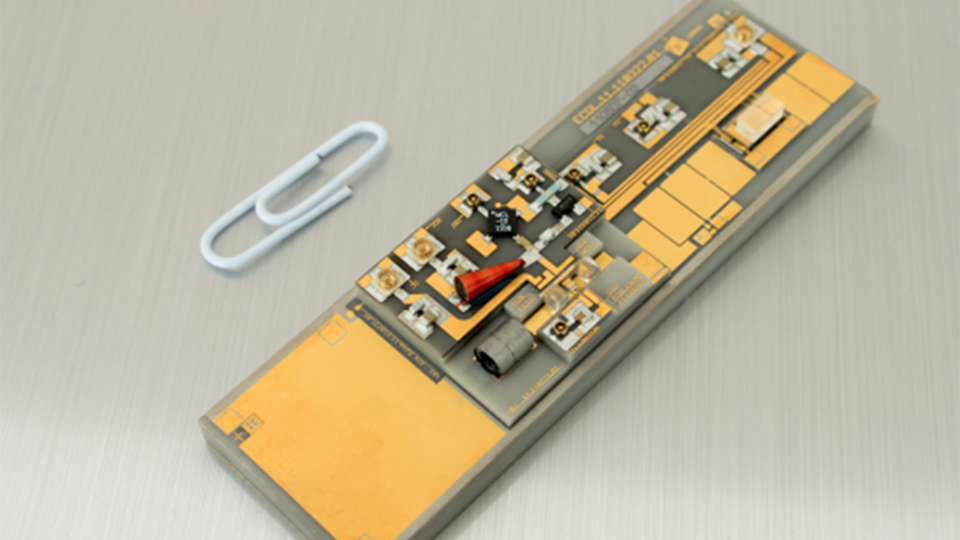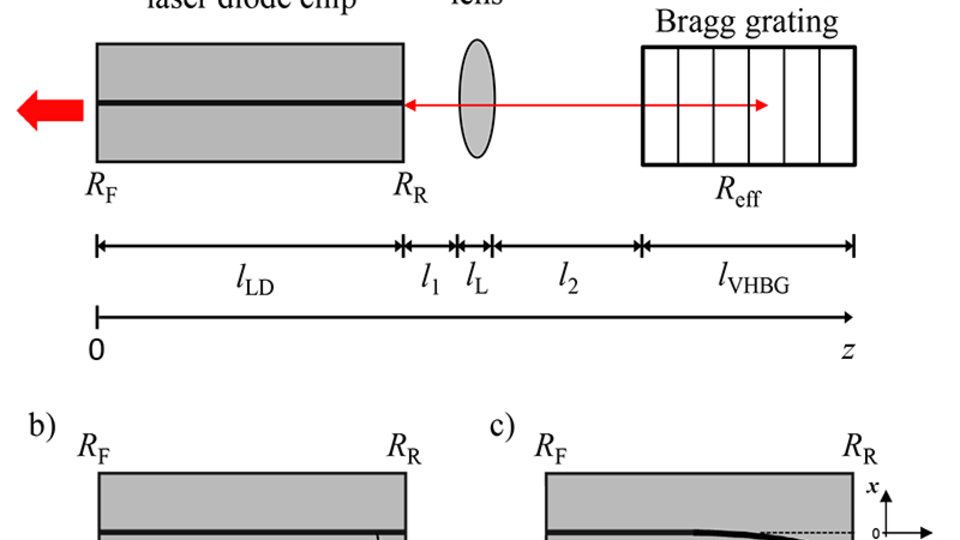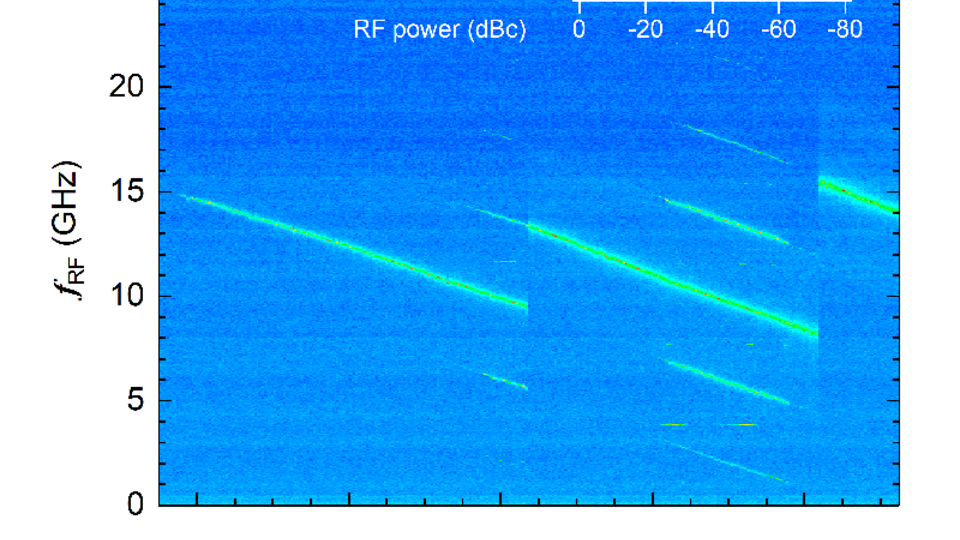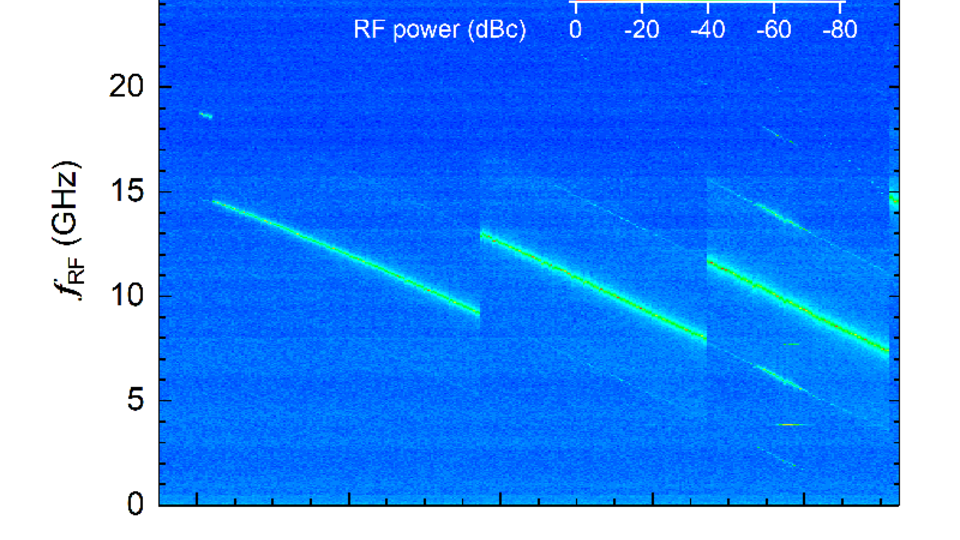Extended cavity diode lasers with angled-facet diode laser chips for improved spectral stability
Fig. 2: Schematic of the ECDL concept (a), laser diode chip with straight waveguide (b), angled-facet laser diode chip (c)
Fig. 3: Experimental results of the electro-optical characterization of ECDL-I. (a) Color-map of the RF-Spectra, (b) side mode suppression ratio
Extended cavity diode lasers (ECDLs, see Fig. 1) have many advantages since they cover a broad spectral range, offer excellent tunability, provide excellent spectral stability and laser linewidths normally better than 100 kHz. They are therefore best suited for precision spectroscopy applications, involving cold atom based quantum sensors, e.g. optical atomic clocks or matter-wave interferometers. However, the coexistence of multiple temporally stable modes is predicted for ECDLs by theory and is also demonstrated experimentally [1,2]. In case of strongly competing modes, especially in the vicinity of a mode-hop, ECDLs no longer feature single longitudinal mode emission and thus a small spectral linewidth.
We have investigated the influence of parasitic Fabry-Pérot modes, oscillating between the facets of the laser diode chip, on the spectral stability of ECDLs. We have determined and compared the dependence of the side mode suppression ratio (SMSR) on the injection current for two ECDLs that feature different levels of suppression of these parasitic Fabry-Pérot modes [3].
Fig. 2a shows schematics of the investigated ECDLs. These use 2 mm long, double quantum well InGaAs/AlGaAs ridge-waveguide (RW) diode laser chips with a ridge width of 5 µm and a volume holographic Bragg grating (VHBG). In both cases the ECDL resonator length is chosen to feature a free spectral range of approximately 4 GHz. The RW diode laser chips differ with respect to the ridge waveguide geometry. One laser chip features a straight RW (ECDL-I, Fig. 2b) and the other an angled-facet RW (ECDL-2, Fig. 2c). Bending of the waveguide allows for a chip layout which features one facet at right angle to the waveguide while the other is at an angle of 3° to the normal of the chip facet. At the latter facet the effective, unwanted back-reflection of RR = 10-3 … 10-4 achievable with anti-reflective coating only is further reduced by two orders of magnitude [3]. This strongly suppresses parasitic Fabry-Pérot modes of the laser chip.
To measure the side mode suppression ratio of the ECDLs, we carry out a heterodyne beat note measurement with a reference laser (a DFB laser in this case) to down-convert the optical spectrum of the ECDLs into the RF domain. The photodiode signal is recorded with an RF spectrum analyzer. The side mode suppression ratio is calculated as the power ratio between the main peak and the respective side mode peak in the RF spectrum.
Fig. 3a, 3b and 3c show the power-current characteristics, the false color map of the RF spectra and the side mode suppression ratio of ECDL-I, whereas Fig. 4a, 4b and 4c show the same respective characteristics of ECDL-2. The ECDLs differ significantly with respect to the smallest injection current at which the SMSR drops to values less than 50 dB. Whereas for ECDL-1 the SMSR drops distinctly already at an injection current of 110 mA, ECDL-2 has to be operated at an injection current of 190 mA to show the same reduction. Further, the current range for which the SMSR is reduced is considerably smaller for ECDL-2 than for ECDL-1. We conclude that ECDL-2 is less prone to non-linear interaction of and competition between longitudinal modes than ECDL-1 and attribute this to the fact that parasitic feedback at the rear facet is significantly smaller for ECDL-2 than for ECDL-1.
The ECDL-chip geometry with an angled-facet waveguide as in ECDL-2 offers a higher spectral purity over a wider range of injection currents. This is due to the higher suppression of parasitic Fabry-Pérot modes resulting from the lower reflectivity at the angled facet as compared to a standard anti-reflection coated straight waveguide. Therefore, ECDLs comprising a gain chip with an angled-facet are better suited for applications where a large tuning range is required, such as in atomic and molecular spectroscopy.
Acknowledgement
This work is funded in parts by the competitive procedure (SAW) of the Leibniz Association under grant number SAW-2013-FBH-3. It was further supported by the Germany Space Agency (DLR) with funds provided by the Federal Ministry for Economic Affairs and Energy (BMWi) according to a decision of the German Federal Parliament (grant number 50 WM 1545).
Publications
[1] M. Radziunas, V.Z. Tronciu, E. Luvsandamdin, C. Kürbis, A. Wicht, H. Wenzel, “Study of Microintegrated External-Cavity Diode Lasers: Simulations, Analysis, and Experiments”, IEEE J. Quantum Electron., vol. 51, no. 2, 2000408 (2015).
[2] V.Z. Tronciu, M. Radziunas, Ch. Kürbis, H. Wenzel, A. Wicht, “Numerical and experimental investigations of micro-integrated external cavity diode lasers”, Opt. Quant. Electron., vol. 47, no. 6, pp. 1459-1464 (2015).
[3] M. Krüger, V.Z. Tronciu, A. Bawamia, C. Kürbis, M. Radziunas, H. Wenzel, A. Wicht, A. Peters, G. Tränkle, "Improving the spectral performance of extended cavity diode lasers using angled‑facet laser diode chips", Appl. Phys. B, 125:66 (2019)



